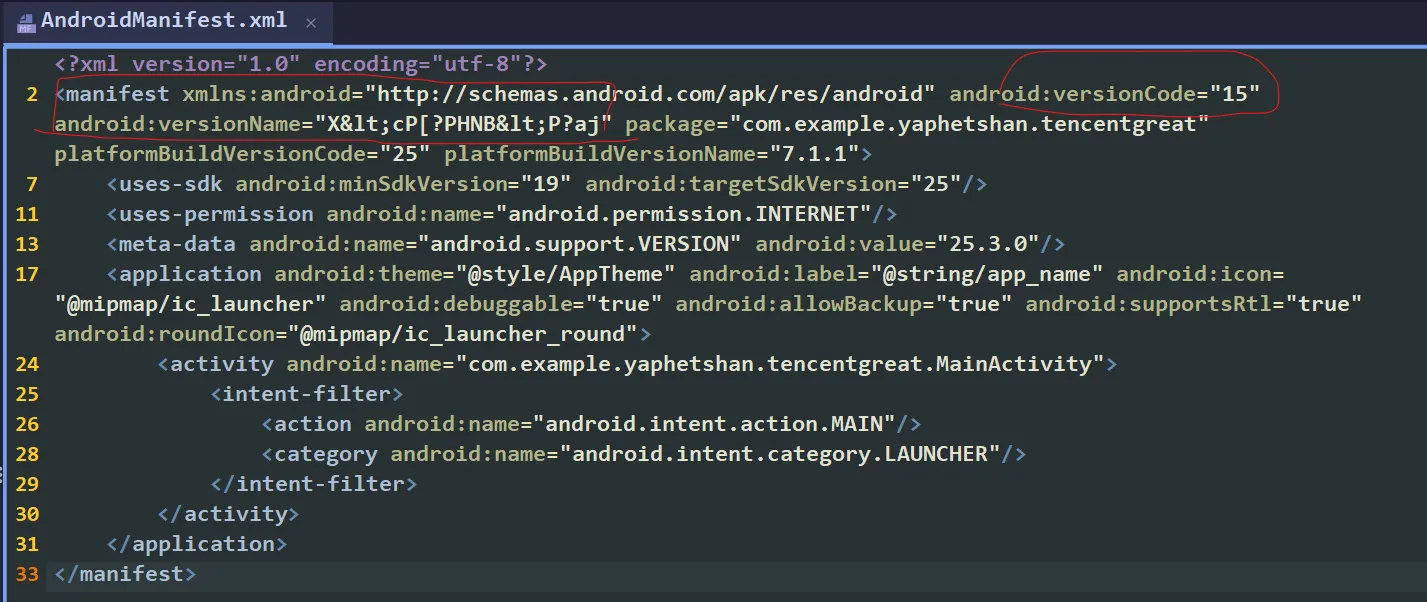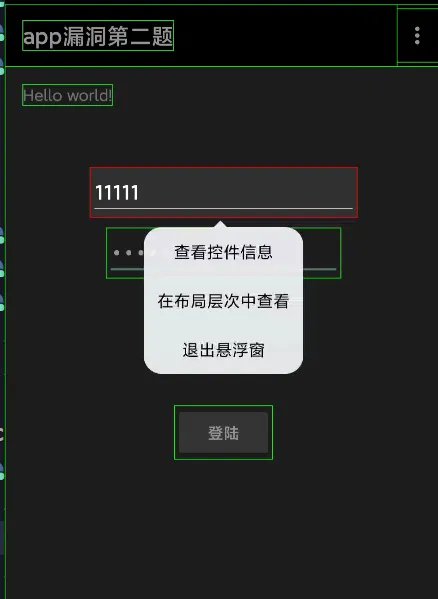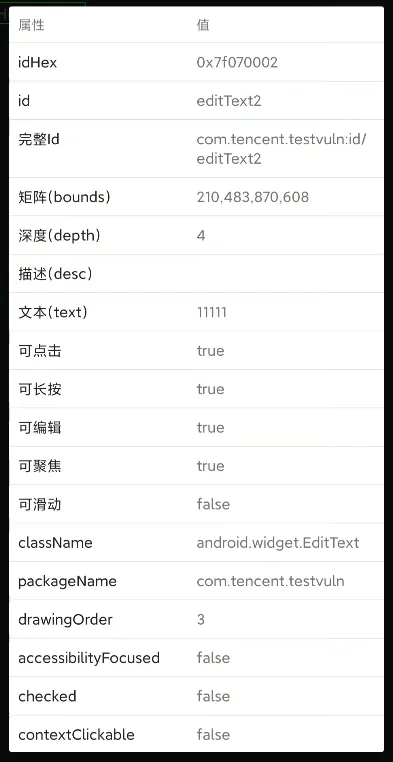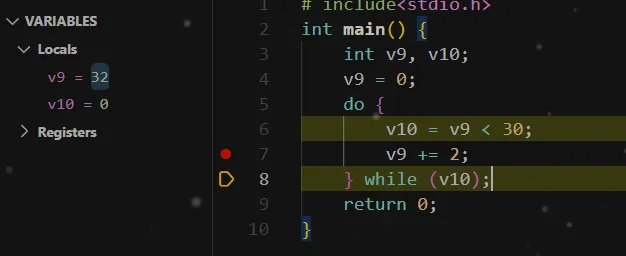website: https://adworld.xctf.org.cn/challenges/list
TOOO EZ
GFSJ0498
public void onClick(View v) {
try {
String inputString = MainActivity.this.text.getText().toString();
PackageInfo pinfo = MainActivity.this.getPackageManager().getPackageInfo(BuildConfig.APPLICATION_ID, 16384);
String versionCode = pinfo.versionName;
int versionName = pinfo.versionCode;
for (int i = 0; i < inputString.length() && i < versionCode.length(); i++) {
if (inputString.charAt(i) != (versionCode.charAt(i) ^ versionName)) {
Toast.makeText(MainActivity.this, "再接再厉,加油~", 1).show();
return;
}
}
if (inputString.length() == versionCode.length()) {
Toast.makeText(MainActivity.this, "恭喜开启闯关之门!", 1).show();
return;
}
} catch (PackageManager.NameNotFoundException e) {
}
Toast.makeText(MainActivity.this, "年轻人不要耍小聪明噢", 1).show();
}
you can see versionCode and versionName directly from xml

def get_correct_string(version_name: str, version_code: int) -> str:
correct_string = ""
for char in version_name:
# Reverse the XOR operation
correct_char = chr(ord(char) ^ version_code)
correct_string += correct_char
return correct_string
# Example usage
version_name = "X<cP[?PHNB<P?aj" # Decoded versionName from XML
version_code = 15 # Version code from XML
correct_input = get_correct_string(version_name, version_code)
print("The correct input string is:", correct_input)
GFSJ0499
knowledge you need to know:
use 界面分析app to check out its id. click the second button.



protected void onCreate(Bundle bundle) {
super.onCreate(bundle);
setContentView(R.layout.activity_main);
this.a = (Button) findViewById(R.id.button1);
this.a.setOnClickListener(this);
this.c = (EditText) findViewById(R.id.editText1);
this.d = (EditText) findViewById(R.id.editText2);
SharedPreferences.Editor edit = getSharedPreferences("test", 0).edit();
edit.putLong("ili", System.currentTimeMillis());
edit.commit();
Log.d("hashcode", SignatureTool.getSignature(this) + "");
}
so we know username input is actually this.d, while pwd input is this.c
public void onClick(View view) {
switch (view.getId()) {
case R.id.button1 /* 2131165187 */:
if (this.c.getText().length() == 0 || this.d.getText().length() == 0) {
Toast.makeText(this, "不能为空", 1).show();
return;
}
String obj = this.c.getText().toString();
String obj2 = this.d.getText().toString();
Log.e("test", obj + " test2 = " + obj2);
Intent intent = new Intent(this, SecondActivity.class);
intent.putExtra("ili", obj);
intent.putExtra("lil", obj2);
startActivity(intent);
return;
default:
return;
}
}
ili = passward string
lil = username string
SecondActivity
protected void onCreate(Bundle bundle) {
super.onCreate(bundle);
setContentView(R.layout.activity_main2);
Intent intent = getIntent();
String stringExtra = intent.getStringExtra("ili"); // passward string
String stringExtra2 = intent.getStringExtra("lil"); // username string
if (Encryto.doRawData(this, stringExtra + stringExtra2).equals("VEIzd/V2UPYNdn/bxH3Xig==")) {
intent.setAction("android.test.action.MoniterInstallService");
intent.setClass(this, MoniterInstallService.class);
intent.putExtra("company", "tencent");
intent.putExtra("name", "hacker");
intent.putExtra("age", 18);
startActivity(intent);
startService(intent);
}
SharedPreferences.Editor edit = getSharedPreferences("test", 0).edit();
edit.putString("ilil", stringExtra);
edit.putString("lili", stringExtra2);
edit.commit();
}
public class Encryto {
public static native int checkSignature(Object obj);
public static native String decode(Object obj, String str);
public static native String doRawData(Object obj, String str);
public static native String encode(Object obj, String str);
public native String HelloLoad();
static {
System.loadLibrary("JNIEncrypt");
}
}
jstring __fastcall doRawData(JNIEnv_ *env, int a2, int this, int str)
{
const char *str0; // r6
const char *v7; // r8
jstring result; // r0
jstring (__fastcall *v9)(JNIEnv *, const jchar *, jsize); // r6
char *v10; // r5
size_t v11; // r2
char keychar[24]; // [sp+0h] [bp-28h] BYREF
if ( j_checkSignature(env) == 1 )
{
strcpy(keychar, "thisisatestkey==");
str0 = env->functions->GetStringUTFChars(env, str, 0);
v7 = (const char *)j_AES_128_ECB_PKCS5Padding_Encrypt(str0, keychar);
env->functions->ReleaseStringUTFChars((JNIEnv *)env, (jstring)str, str0);
result = env->functions->NewStringUTF(env, v7);
}
else
{
v9 = env->functions->NewString;
v10 = UNSIGNATURE[0];
v11 = strlen(UNSIGNATURE[0]);
result = v9(&env->functions, (const jchar *)v10, v11);
}
return result;
}
To reverse-engineer the decryption and derive the string "VEIzd/V2UPYNdn/bxH3Xig==" after applying Base64 encoding, we can analyze the provided C code.
Observations from the Code:
- Key Used:
"thisisatestkey=="is the AES key used for encryption/decryption. - AES Mode: AES-128-ECB with PKCS5 padding is used.
- Decryption Logic:
- Input
stris encrypted usingj_AES_128_ECB_PKCS5Padding_Encrypt. - To reverse this, we need to decrypt the ciphertext.
- Input
Python Code:
Below is the Python implementation to reverse the encryption and decrypt the string to derive the required result:
from Crypto.Cipher import AES
import base64
def decrypt_and_base64(ciphertext: str, key: str) -> str:
# Convert the key and ciphertext to bytes
key_bytes = key.encode('utf-8')
ciphertext_bytes = base64.b64decode(ciphertext)
# Ensure the key is 16 bytes (AES-128 requires a 16-byte key)
assert len(key_bytes) == 16, "Key must be 16 bytes for AES-128"
# Create AES cipher in ECB mode
cipher = AES.new(key_bytes, AES.MODE_ECB)
# Decrypt the ciphertext
decrypted_bytes = cipher.decrypt(ciphertext_bytes)
# Remove PKCS5 padding
pad_len = decrypted_bytes[-1]
decrypted_bytes = decrypted_bytes[:-pad_len]
# Convert to string and re-encode in Base64
decrypted_str = decrypted_bytes.decode('utf-8')
# encoded_result = base64.b64encode(decrypted_str.encode('utf-8')).decode('utf-8')
return decrypted_str
ciphertext = "VEIzd/V2UPYNdn/bxH3Xig==" # Replace this with the actual encrypted string
key = "thisisatestkey=="
result = decrypt_and_base64(ciphertext, key)
print("Result:", result)
and, boom, the app crushed. here is the reason: just open xml file if you need ;)
Service: The service com.tencent.testvuln.MoniterInstallService is successfully started because:
- It is registered with the action
"android.test.action.MoniterInstallService". - The
startService(intent)call will launch it.
Activity: The startActivity(intent) call will not launch any activity because:
- No activity is declared with an
intent-filtermatching the action"android.test.action.MoniterInstallService". - This will likely cause the app to crash with an
ActivityNotFoundException.
GFSJ0500
I CANT EVEN OPEN IT. pass, i will crack it later :(
GFSJ0505
bool __fastcall Java_com_testjava_jack_pingan2_cyberpeace_CheckString(JNIEnv_ *env, __int64 a2, __int64 str)
{
const char *str_1; // x20
__int64 v4; // x0
signed int v5; // w21
unsigned __int64 v6; // x22
_BYTE *v7; // x0
_BYTE *v8; // x19
size_t v9; // w2
unsigned __int64 v10; // x20
_BYTE *v11; // x8
char v12; // w9
char v13; // w10
char v14; // w9
__int64 v15; // x20
_BYTE *v16; // x8
char v17; // w10
unsigned __int64 v18; // x0
unsigned __int64 v19; // x8
str_1 = env->functions->GetStringUTFChars(env, str, 0LL);
v4 = strlen(str_1);
v5 = v4;
v6 = ((v4 << 32) + 0x100000000LL) >> 32;
v7 = malloc(((v4 << 32) + 0x100000000LL) >> 32);
v8 = v7;
if ( v6 > v5 )
v9 = v6 - v5;
else
v9 = 0;
memset(&v7[v5], 0, v9);
memcpy(v8, str_1, v5);
if ( strlen(v8) >= 2uLL )
{
v10 = 0LL;
do
{
v11 = &v8[v10];
v12 = v8[v10 + 16];
v13 = v8[v10++];
*v11 = v12;
v11[16] = v13;
}
while ( strlen(v8) >> 1 > v10 );
}
if ( *v8 )
{
v14 = v8[1];
v8[1] = *v8;
*v8 = v14;
if ( strlen(v8) >= 3uLL )
{
v15 = 0LL;
do
{
v16 = &v8[v15];
v17 = v8[v15 + 2];
v16[2] = v8[v15 + 3];
v16[3] = v17;
v18 = strlen(v8);
v19 = v15 + 4;
v15 += 2LL;
}
while ( v18 > v19 );
}
}
return strcmp(v8, "f72c5a36569418a20907b55be5bf95ad") == 0;
}
return 1 should be fine. v8 = “f72c5a36569418a20907b55be5bf95ad”
def reverse_check_string(target: str) -> str:
# Initialize the transformed string as the target
v8 = list(target) # Work with the string as a list of characters
# Reverse the final block-swapping logic
if len(v8) >= 3:
v15 = len(v8) - 4
while v15 >= 0:
v8[v15 + 3], v8[v15 + 2] = v8[v15 + 2], v8[v15 + 3]
v15 -= 2
# Reverse the first two-character swap
if len(v8) >= 2:
v8[0], v8[1] = v8[1], v8[0]
# Reverse the 16-character swap logic
if len(v8) >= 2:
v10 = len(v8) // 2 - 1
while v10 >= 0:
v8[v10], v8[v10 + 16] = v8[v10 + 16], v8[v10]
v10 -= 1
# Convert the list back to a string
transformed_str = "".join(v8)
return transformed_str
# Example usage
target_hash = "f72c5a36569418a20907b55be5bf95ad" # Target string to match
original_str = reverse_check_string(target_hash)
print("The original input string (str) is:", original_str)
Step 1: Input String and Initial Setup
C Code:
str_1 = env->functions->GetStringUTFChars(env, str, 0LL);
v4 = strlen(str_1);
v5 = v4;
v6 = ((v4 << 32) + 0x100000000LL) >> 32;
v7 = malloc(((v4 << 32) + 0x100000000LL) >> 32);
v8 = v7;
if (v6 > v5)
v9 = v6 - v5;
else
v9 = 0;
memset(&v7[v5], 0, v9);
memcpy(v8, str_1, v5);
- The input
stris retrieved usingGetStringUTFChars. - Memory is allocated for
v8to hold the same size asstr_1. - The contents of
str_1are copied tov8.
Python Equivalent:
v8 = list(target) # Target string (to match the output "f72c5a36569418a20907b55be5bf95ad")
- In Python, we directly start with the target string as a list of characters (
v8).
Step 2: 16-Character Swap
C Code:
if (strlen(v8) >= 2uLL) {
v10 = 0LL;
do {
v11 = &v8[v10];
v12 = v8[v10 + 16];
v13 = v8[v10++];
*v11 = v12;
v11[16] = v13;
} while (strlen(v8) >> 1 > v10);
}
- For each character in the first half of the string, swap it with the character 16 positions ahead (
v8[v10] <-> v8[v10 + 16]). - The loop runs until
strlen(v8) >> 1. strlen(v8) >> 1is equivalent tolen(v8) // 2in Python, where//denotes integer division.
Python Equivalent (Reversed):
if len(v8) >= 2:
v10 = len(v8) // 2 - 1
while v10 >= 0:
v8[v10], v8[v10 + 16] = v8[v10 + 16], v8[v10]
v10 -= 1
- In Python, the logic is reversed: Start from the last index (
len(v8) // 2 - 1) and iterate backward, swapping characters atv10andv10 + 16.
Step 3: First Two Characters Swap
C Code:
if (*v8) {
v14 = v8[1];
v8[1] = *v8;
*v8 = v14;
}
- The first two characters of the string are swapped (
v8[0] <-> v8[1]).
Python Equivalent (Reversed):
if len(v8) >= 2:
v8[0], v8[1] = v8[1], v8[0]
- Reverse the swap by swapping
v8[0]andv8[1]again.
Step 4: Final Block-Swapping Logic
C Code:
if (strlen(v8) >= 3uLL) { // len(v8) == 32
v15 = 0LL;
do {
v16 = &v8[v15];
v17 = v8[v15 + 2];
v16[2] = v8[v15 + 3];
v16[3] = v17;
v18 = strlen(v8);
v19 = v15 + 4; // 28 + 4 = 32, jump out of the block
v15 += 2LL;
} while (v18 > v19);
}
- For every two characters in the string, swap the 3rd and 4th characters in blocks of 4 (
v8[v15 + 2] <-> v8[v15 + 3]). - The loop increments by 2 each time (
v15 += 2).
Python Equivalent (Reversed):
if len(v8) >= 3:
v15 = len(v8) - 4 # final 4 characters do nothing
while v15 >= 0:
v8[v15 + 3], v8[v15 + 2] = v8[v15 + 2], v8[v15 + 3]
v15 -= 2
- Start from the end of the string (
len(v8) - 4) and iterate backward in steps of 2, swapping characters atv15 + 2andv15 + 3.
Step 5: Final Comparison
C Code:
return strcmp(v8, "f72c5a36569418a20907b55be5bf95ad") == 0;
- The transformed string (
v8) is compared to the target string"f72c5a36569418a20907b55be5bf95ad". - If they are equal, the function returns
true.
Python Equivalent:
transformed_str = "".join(v8)
return transformed_str == target
- After reversing all transformations, check if the resulting string matches the target.
Full Python Code (with Reversing):
def reverse_check_string(target: str) -> str:
# Initialize the transformed string as the target
v8 = list(target) # Work with the string as a list of characters
# Reverse the final block-swapping logic
if len(v8) >= 3:
v15 = len(v8) - 4
while v15 >= 0:
v8[v15 + 3], v8[v15 + 2] = v8[v15 + 2], v8[v15 + 3]
v15 -= 2
# Reverse the first two-character swap
if len(v8) >= 2:
v8[0], v8[1] = v8[1], v8[0]
# Reverse the 16-character swap logic
if len(v8) >= 2:
v10 = len(v8) // 2 - 1
while v10 >= 0:
v8[v10], v8[v10 + 16] = v8[v10 + 16], v8[v10]
v10 -= 1
# Convert the list back to a string
transformed_str = "".join(v8)
return transformed_str
# Example usage
target_hash = "f72c5a36569418a20907b55be5bf95ad" # Target string to match
original_str = reverse_check_string(target_hash)
print("The original input string (str) is:", original_str)
Key Insights:
- Both C and Python handle memory and string operations differently.
- In C, memory is manually managed with
mallocandmemcpy. In Python, we use lists for mutable strings. - The transformation logic in both implementations is the same; the Python version reverses the transformations step by step.
GFSJ0504
public boolean a(String str) {
try {
return ncheck(new a().a(str.getBytes()));
} catch (Exception e) {
return false;
}
}
private native boolean ncheck(String str);
package com.a.easyjni;
/* loaded from: classes.dex */
public class a {
private static final char[] a = {'i', '5', 'j', 'L', 'W', '7', 'S', '0', 'G', 'X', '6', 'u', 'f', '1', 'c', 'v', '3', 'n', 'y', '4', 'q', '8', 'e', 's', '2', 'Q', '+', 'b', 'd', 'k', 'Y', 'g', 'K', 'O', 'I', 'T', '/', 't', 'A', 'x', 'U', 'r', 'F', 'l', 'V', 'P', 'z', 'h', 'm', 'o', 'w', '9', 'B', 'H', 'C', 'M', 'D', 'p', 'E', 'a', 'J', 'R', 'Z', 'N'};
public String a(byte[] bArr) {
StringBuilder sb = new StringBuilder();
for (int i = 0; i <= bArr.length - 1; i += 3) {
byte[] bArr2 = new byte[4];
byte b = 0;
for (int i2 = 0; i2 <= 2; i2++) {
if (i + i2 <= bArr.length - 1) {
bArr2[i2] = (byte) (b | ((bArr[i + i2] & 255) >>> ((i2 * 2) + 2)));
b = (byte) ((((bArr[i + i2] & 255) << (((2 - i2) * 2) + 2)) & 255) >>> 2);
} else {
bArr2[i2] = b;
b = 64;
}
}
bArr2[3] = b;
for (int i3 = 0; i3 <= 3; i3++) {
if (bArr2[i3] <= 63) {
sb.append(a[bArr2[i3]]);
} else {
sb.append('=');
}
}
}
return sb.toString();
}
}
bool __fastcall Java_com_a_easyjni_MainActivity_ncheck(JNIEnv_ *env, int a2, int str)
{
const char *str_1; // r6
int i; // r0
char *v7; // r2
char v8; // r1
int v9; // r0
bool v10; // cc
_BOOL4 result; // r0
char v12[32]; // [sp+3h] [bp-35h] BYREF
char v13; // [sp+23h] [bp-15h]
str_1 = env->functions->GetStringUTFChars(env, str, 0);
if ( strlen(str_1) == 32 )
{
for ( i = 0; i != 16; ++i )
{
v7 = &v12[i];
v12[i] = str_1[i + 16];
v8 = str_1[i];
v7[16] = v8;
}
env->functions->ReleaseStringUTFChars(env, str, str_1);
v9 = 0;
do
{
v10 = v9 < 30;
v13 = v12[v9];
v12[v9] = v12[v9 + 1];
v12[v9 + 1] = v13;
v9 += 2;
}
while ( v10 );
result = memcmp(v12, "MbT3sQgX039i3g==AQOoMQFPskB1Bsc7", 0x20u) == 0;
}
else
{
env->functions->ReleaseStringUTFChars(env, str, str_1);
result = 0;
}
return result;
}
To reverse-engineer the value of str such that the function returns true, we need to reverse the transformations applied to the input str to produce the expected output MbT3sQgX039i3g==AQOoMQFPskB1Bsc7. Here’s how the logic maps step by step from C to Python.
Step-by-Step Analysis
1. Input String Validation
if (strlen(str_1) == 32)
The input str must be exactly 32 characters long. If not, the function returns false.
2. Reordering Bytes
for (i = 0; i != 16; ++i) {
v7 = &v12[i];
v12[i] = str_1[i + 16];
v8 = str_1[i];
v7[16] = v8;
}
- The first 16 characters (
str_1[0:16]) are moved to the second half of thev12array. - The second 16 characters (
str_1[16:32]) are moved to the first half of thev12array.
Essentially:
v12[0:16] = str_1[16:32]v12[16:32] = str_1[0:16]
3. Swapping Adjacent Bytes
do
{
v10 = v9 < 30;
v13 = v12[v9];
v12[v9] = v12[v9 + 1];
v12[v9 + 1] = v13;
v9 += 2;
}
while ( v10 );
Starting from the beginning of
v12, every pair of adjacent bytes is swapped:v12[0] <-> v12[1]v12[2] <-> v12[3]- …
v12[28] <-> v12[29]v12[30] <-> v12[31]

This transforms the array into a shuffled version.
4. Final Comparison
memcmp(v12, "MbT3sQgX039i3g==AQOoMQFPskB1Bsc7", 0x20u) == 0;
- The transformed
v12must match the target string"MbT3sQgX039i3g==AQOoMQFPskB1Bsc7".
Reversing the Transformations
We need to reverse the steps:
- Reverse the adjacent byte swaps (Step 3).
- Reverse the reordering of bytes (Step 2).
- Ensure the final reversed
stris 32 characters long.
Python Code
Here is the Python implementation to reverse-engineer str:
def reverse_ncheck(target: str) -> str:
# Step 1: Convert the target string to a list of characters
v12 = list(target)
# Step 2: Reverse the adjacent byte swaps
for v9 in range(0, 32, 2): # Swap every pair of adjacent characters
v12[v9], v12[v9 + 1] = v12[v9 + 1], v12[v9]
# Step 3: Reverse the byte reordering
str_1 = [""] * 32 # Placeholder for the original string
str_1[0:16] = v12[16:32] # Move v12[16:32] back to str_1[0:16]
str_1[16:32] = v12[0:16] # Move v12[0:16] back to str_1[16:32]
# Step 4: Return the reconstructed input string
return "".join(str_1)
# Target string to reverse-engineer
target = "MbT3sQgX039i3g==AQOoMQFPskB1Bsc7"
reversed_str = reverse_ncheck(target)
print("The value of str is:", reversed_str)
The value of str is: QAoOQMPFks1BsB7cbM3TQsXg30i9g3==
reverse-engineer the input value of str that produces the return value QAoOQMPFks1BsBc7bM3TQsXg30i9g3== in the a().a(byte[] bArr) method:
# Define the character mapping array
a = [
'i', '5', 'j', 'L', 'W', '7', 'S', '0', 'G', 'X', '6', 'u', 'f', '1', 'c', 'v',
'3', 'n', 'y', '4', 'q', '8', 'e', 's', '2', 'Q', '+', 'b', 'd', 'k', 'Y', 'g',
'K', 'O', 'I', 'T', '/', 't', 'A', 'x', 'U', 'r', 'F', 'l', 'V', 'P', 'z', 'h',
'm', 'o', 'w', '9', 'B', 'H', 'C', 'M', 'D', 'p', 'E', 'a', 'J', 'R', 'Z', 'N'
]
# Reverse mapping of character to its index in the array
char_to_index = {ch: idx for idx, ch in enumerate(a)}
# Target encoded string
target = "QAoOQMPFks1BsB7cbM3TQsXg30i9g3=="
def reverse_encode(target):
# Step 1: Remove padding
target = target.rstrip("=")
# Step 2: Convert characters back to 6-bit values
bArr2 = [char_to_index[ch] for ch in target]
# Step 3: Reconstruct the original bytes
bArr = []
for i in range(0, len(bArr2), 4):
# Get the current chunk of 4 characters (6-bit values)
chunk = bArr2[i:i + 4]
# Pad the chunk with zeroes if it's less than 4 characters
while len(chunk) < 4:
chunk.append(0)
# Reconstruct the 3 original bytes from the 4 encoded characters
b1 = ((chunk[0] << 2) | (chunk[1] >> 4)) & 0xFF
bArr.append(b1)
if len(chunk) > 1 and chunk[2] < 64: # If not padding
b2 = ((chunk[1] << 4) | (chunk[2] >> 2)) & 0xFF
bArr.append(b2)
if len(chunk) > 2 and chunk[3] < 64: # If not padding
b3 = ((chunk[2] << 6) | chunk[3]) & 0xFF
bArr.append(b3)
# Convert the result to a string
return bytes(bArr).decode("latin1")
# Reverse-engineer the value of `str`
reversed_str = reverse_encode(target)
print("The value of str is:", reversed_str)
here is a more concise version on the internet
def decode(base64_str):
base64_charset = "i5jLW7S0GX6uf1cv3ny4q8es2Q+bdkYgKOIT/tAxUrFlVPzhmow9BHCMDpEaJRZN"
base64_bytes = ['{:0>6}'.format(str(bin(base64_charset.index(s))).replace('0b', '')) for s in base64_str if
s != '=']
resp = bytearray()
nums = len(base64_bytes) // 4
remain = len(base64_bytes) % 4
integral_part = base64_bytes[0:4 * nums]
while integral_part:
tmp_unit = ''.join(integral_part[0:4])
tmp_unit = [int(tmp_unit[x: x + 8], 2) for x in [0, 8, 16]]
for i in tmp_unit:
resp.append(i)
integral_part = integral_part[4:]
if remain:
remain_part = ''.join(base64_bytes[nums * 4:])
tmp_unit = [int(remain_part[i * 8:(i + 1) * 8], 2) for i in range(remain - 1)]
for i in tmp_unit:
resp.append(i)
return resp
if __name__ == '__main__':
flag_1 = 'MbT3sQgX039i3g==AQOoMQFPskB1Bsc7'
print('加密后的字符串:',flag_1)
flag_2 = ''
for i in range(len(flag_1)//2):
flag_2 += flag_1[i*2+1] + flag_1[i*2]
print('前后两位调换位置:',flag_2)
flag_3 = flag_2[len(flag_2)//2:] + flag_2[0:len(flag_2)//2]
print('前后16位调换位置:',flag_3)
print('解密后:',decode(flag_3))
